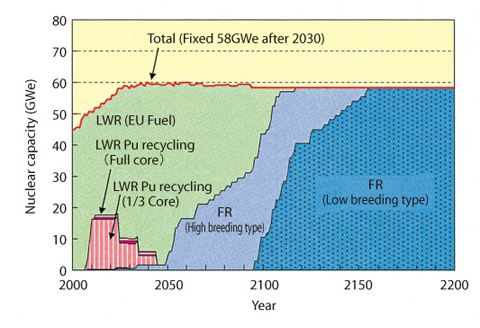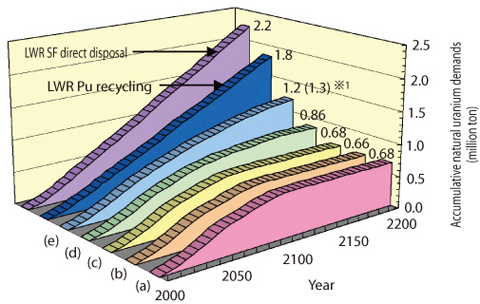Table1-2 Candidate in the phase II of Feasibility Study on commercialized FR cycle systems

Fig.1-19 The shift from phase II candidate (a) LWR to FR

Fig.1-20 Accumulative natural uranium demands of the phase II candidates
*1 Accumulative demands up to 2300 when the shift to Water-cooled reactor from LWR will be complete
Regarding the Fast Reactor (FR) cycle which is expected to provide efficient use of uranium resources and the reduction of high-level radioactive wastes, the Japan Cabinet Council decided on October 14th 2005 that the government shall respect the Framework for Nuclear Energy Policy which will aim at a commercial base for the FR cycle by 2050. JAEA is carrying out a "Feasibility Study on commercialized FR cycle systems" (FS) to present a scenario for FR cycle actualization and an R&D plan for commercialization to the government by 2015. In the phase I research finished in fiscal 2005, scenario analysis of deployment from a LWR cycle to FR cycle was performed for a typical candidate (Table1-2) among several that combine the FR and Fuel cycle system.
The FR cycle deployment scenario analysis and the cycle material flow analysis estimated parameters for future nuclear capacity, planned fuel cycle facilities, start time of FR cycle system installation to be completed by 2050, the recycling method of MA contained in LWR spent fuel reprocessing waste fluid, etc. This scenario analysis estimated each candidate FR cycle system regarding deployment period from LWR to FR, the accumulative natural uranium demands, LWR spent fuel quantity to be stored, amount of high-level-waste to be stored, etc. The FR cycle deployment scenario analysis assumes that high breeding FRs are introduced replacing LWRs which finish their life and low breeding FRs are gradually introduced keeping plutonium demand/supply balance. In concept (a), the shift from LWR to FR 2100 will be complete under the conditions of the New Nuclear Policy-Planning Council (i.e. future nuclear capacity is fixed at 58 GWe in 2030 and FR introduction starts in 2050) (Fig.1-19). Fig.1-20 shows the accumulative natural uranium demand of several nuclear scenarios. In LWR SF direct disposal and LWR plutonium recycling, the accumulative natural uranium demand continues to increase. On the other hand, the demand of the candidates (a) ~ (d) reaches saturation at the beginning or middle of the next century and then does not require importation of natural uranium. This result shows that nuclear power can be sustainable.
One scenario analysis result is that in shortening the deployment period from LWR to FR as much as possible and lowering natural uranium use, small in-core plutonium inventory and a FR system with a high breeding ratio is desirable, and especially in the transition term the plutonium recovered from the spent fuel of LWR and breeding FR must be used effectively.